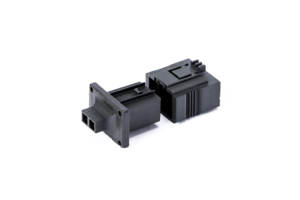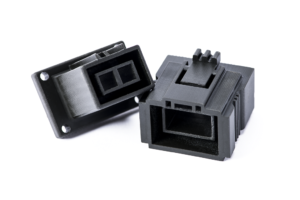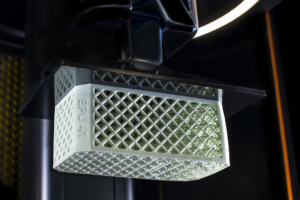 Carbon may be known for its groundbreaking DLS technology, but its materials are an important part of that technology as the company understands the importance of a full ecosystem approach. Carbon’s customizable, production-grade resins were among the first to make plastic 3D printing a production rather than just a prototyping technology.
Carbon may be known for its groundbreaking DLS technology, but its materials are an important part of that technology as the company understands the importance of a full ecosystem approach. Carbon’s customizable, production-grade resins were among the first to make plastic 3D printing a production rather than just a prototyping technology.
Today, the company announces two new materials: Epoxy (EPX) 82 and Elastomeric Polyurethane (EPU) 41.
“The world’s most innovative companies are adopting digital 3D Manufacturing and Carbon is helping accelerate this growth through our expanding portfolio of production-ready materials,” said Jason Rolland, Vice President of Materials at Carbon. “At Carbon, we are constantly pushing the boundaries to create solutions for producing more durable, higher quality end-use parts. The introduction of EPX 82 and EPU 41 is a testament to this, and further validates our vision to fundamentally change how the world designs, engineers, makes, and delivers products.”
EPX 82 is a high-strength engineering material with good impact strength and a heat deflection temperature of 125°C. It’s well-suited for applications that require a balance of strength, toughness and thermo-cycling durability, such as connectors, brackets and housings in the automotive and industrial sectors. Its mechanical properties are comparable to lightly glass-filled thermoplastics and meet USCAR-2 fluid compatibility standards.
- T2 electrical connector made with EPX 82
- T2 electrical connector made with EPX 82
- Topology optimized lever made with EPX 82 used in auto and industrial load-bearing functional parts
“When selecting a material for the production of electrical connector housings, it is critical that the material is tough and allows for flex-features to perform adequately, yet stiff enough to yield strong, thin-walled geometries,” said Jerry Rhinehart, Manager of Additive Manufacturing Development, Aptiv (formerly Delphi). “These mechanical properties must also be maintained as the connector withstands harsh environmental conditions, including temperature-humidity cycling and exposure to caustic chemicals. Carbon’s newly released EPX 82 provides a level of performance that allows us to tackle the USCAR-2 T2 temperature class of connection systems. Our confidence in this material enables our product development engineers to free their minds from the design constraints imposed by traditional manufacturing processes, paving the way for the creation of connectors that outperform their injection-molded counterparts by adding value through geometric complexity.”
EPU 41 is the latest in Carbon’s family of elastomeric materials, which also includes SIL 30 and EPU 40. It can produce elastomeric lattice geometries that can outperform traditional foams. Compared to EPU 40, it has higher resilience and room and low temperatures, and its properties include good tear strength, elongation and energy return, making it a good choice for applications requiring cushioning, impact absorption, and comfort. It also performs well in functional testing, including fatigue, hydrolysis, UV-stability, and plastic deformation tests.
- Printing of lattice puck made with EPU 41 used for consumer applications such as helmets, gloves, shin guards
EPU 41 is offered only in five-liter bulk packaging, and is the second material after RPU 70 to be offered under Carbon’s production-scale materials pricing of $150 per liter. It requires an MMD (meter, mix and dispense) device for proper dispensing of the material in bulk quantities.
 The two new resins are currently available to North American customers; information about global availability will be forthcoming at a later date.
The two new resins are currently available to North American customers; information about global availability will be forthcoming at a later date.
Carbon will be at NPE next week, which is taking place from May 7th to May 11th in Orlando, Florida. If you’re attending, you can visit Carbon and learn more about its new materials at Booth #S24160.
Discuss this and other 3D printing topics at 3DPrintBoard.com or share your thoughts below.
[Images: Carbon]
Subscribe to Our Email Newsletter
Stay up-to-date on all the latest news from the 3D printing industry and receive information and offers from third party vendors.
You May Also Like
Profiling a Construction 3D Printing Pioneer: US Army Corps of Engineers’ Megan Kreiger
The world of construction 3D printing is still so new that the true experts can probably be counted on two hands. Among them is Megan Kreiger, Portfolio Manager of Additive...
US Army Corps of Engineers Taps Lincoln Electric & Eaton for Largest 3D Printed US Civil Works Part
The Soo Locks sit on the US-Canadian border, enabling maritime travel between Lake Superior and Lake Huron, from which ships can reach the rest of the Great Lakes. Crafts carrying...
Construction 3D Printing CEO Reflects on Being Female in Construction
Natalie Wadley, CEO of ChangeMaker3D, could hear the words of her daughter sitting next to her resounding in her head. “Mum, MUM, you’ve won!” Wadley had just won the prestigious...
1Print to Commercialize 3D Printed Coastal Resilience Solutions
1Print, a company that specializes in deploying additive construction (AC) for infrastructure projects, has entered an agreement with the University of Miami (UM) to accelerate commercialization of the SEAHIVE shoreline...


































